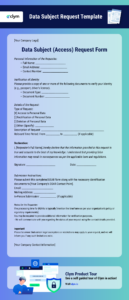Utilizing a standardized structure offers several advantages. It reduces the risk of errors and omissions, ensuring all necessary information is included in each response. This improves operational efficiency by minimizing time spent drafting individual replies. Furthermore, it enhances transparency and builds trust with individuals by providing clear and comprehensive information about how their data is handled. Consistent responses also contribute to demonstrable compliance with legal obligations, mitigating potential risks and penalties.
This article will further explore key elements for constructing these frameworks, common challenges encountered in their implementation, and best practices for ensuring effective and compliant responses to data access requests.
Key Components of a Data Subject Access Request Response
Effective responses to access requests require careful consideration of several key components to ensure comprehensive and compliant communication.
1: Acknowledgment of Receipt: Prompt acknowledgment confirms receipt of the request and initiates the response process. This acknowledgment should include a unique reference number for tracking and future communication.
2: Requestor Verification: Verification procedures ensure responses are provided only to authorized individuals. This process may involve requesting specific identifying information.
3: Summary of Request: A concise summary of the request clarifies the information sought by the individual. This aids in accurate and relevant data retrieval.
4: Information Provided: This section comprises the actual data disclosed in response to the request. It should be presented in a clear, understandable format.
5: Information Withheld (If Applicable): If any information is withheld, clear and legally valid reasons for the withholding must be provided. References to relevant legal provisions supporting the withholding should be included.
6: Right to Rectification: Information regarding the individual’s right to request rectification of inaccurate or incomplete data should be included.
7: Right to Complain: Individuals should be informed of their right to lodge a complaint with a supervisory authority if they are dissatisfied with the handling of their request.
8: Contact Information: Providing clear contact details facilitates further communication regarding the request or related inquiries. This allows individuals to easily follow up or seek clarification if needed.
These components work together to create a robust and compliant response, ensuring transparency and facilitating the individual’s exercise of their data rights. A well-structured response strengthens trust and demonstrates a commitment to data protection principles.
How to Create a Data Subject Access Request Response Template
Creating a standardized template for responding to data subject access requests (DSARs) promotes efficiency and ensures consistent compliance with data privacy regulations. The following steps outline the process of developing such a template.
1: Define Scope and Purpose: Clearly define the scope of the template, specifying the types of data requests it covers. Outline the template’s purpose in facilitating compliant and efficient responses.
2: Structure the Template: Establish a clear structure with distinct sections for essential components, such as acknowledgment, requestor verification, summary of the request, information provided, reasons for withholding information (if applicable), rights of rectification and complaint, and contact information. This structured format ensures comprehensive responses.
3: Draft Standard Language: Develop standardized language for each section of the template, ensuring clarity, accuracy, and legal compliance. Pre-written text can be adapted for specific requests, saving time and resources.
4: Incorporate Legal Requirements: Integrate relevant legal provisions and regulatory guidance into the template. This ensures responses align with applicable data protection laws and demonstrates compliance.
5: Test and Refine: Thoroughly test the template with various scenarios to identify potential gaps or areas for improvement. Refine the template based on testing feedback to optimize its effectiveness and ensure practical application.
6: Implement and Train: Implement the finalized template within the organization’s processes. Train relevant personnel on proper template usage to ensure consistent and accurate application across all responses.
7: Regularly Review and Update: Periodically review and update the template to reflect changes in legislation, regulatory guidance, or organizational policies. This maintains ongoing compliance and effectiveness.
A well-designed template streamlines the DSAR response process, promoting both efficiency and compliance. Consistent application of the template across the organization strengthens data protection practices and minimizes the risk of errors or omissions. Regular review and updates ensure the template remains effective and aligned with evolving regulatory requirements.
Standardized frameworks for addressing inquiries about personal data held by organizations are crucial for navigating the complexities of data privacy regulations. These structured formats provide a foundation for efficient and consistent responses, ensuring individuals receive timely access to their information while simultaneously mitigating organizational risk. Key components of such a framework include prompt acknowledgment, robust verification procedures, clear summaries of requests, and comprehensive disclosure of information. Additionally, addressing the rights of rectification and complaint empowers individuals and reinforces transparency. Developing, implementing, and regularly updating these frameworks require careful consideration of legal requirements, organizational policies, and best practices.
Organizations must prioritize the development and maintenance of robust processes for handling these requests. Effective management of personal data fosters trust, strengthens accountability, and demonstrates a commitment to data protection principles. In the evolving landscape of data privacy, proactive measures and well-defined procedures are essential for safeguarding individual rights and ensuring sustainable compliance.

